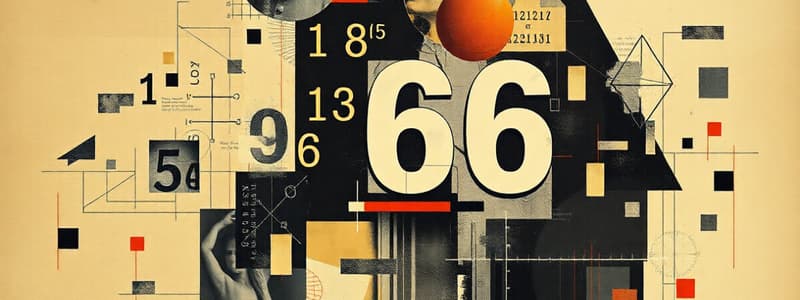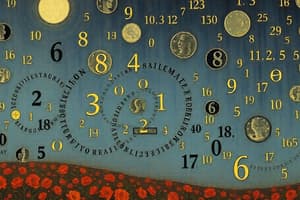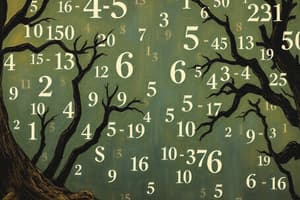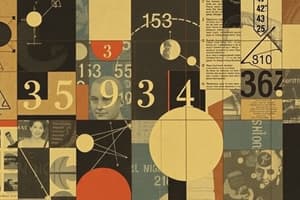Podcast
Questions and Answers
What type of numbers can be expressed as a fraction where both the numerator and denominator are integers and the denominator is not zero?
What type of numbers can be expressed as a fraction where both the numerator and denominator are integers and the denominator is not zero?
- Irrational numbers
- Rational numbers (correct)
- Complex numbers
- Imaginary numbers
Which area of mathematics focuses on the study of shapes and their properties in two and three dimensions?
Which area of mathematics focuses on the study of shapes and their properties in two and three dimensions?
- Statistics
- Geometry (correct)
- Algebra
- Logic
What is the result of raising a number to the power of zero?
What is the result of raising a number to the power of zero?
- It equals the number squared
- It equals the number itself
- It equals one (correct)
- It equals zero
In calculus, what does differentiation primarily focus on?
In calculus, what does differentiation primarily focus on?
Which of the following correctly defines a set in set theory?
Which of the following correctly defines a set in set theory?
Which statistical measure represents the middle value in a sorted data set?
Which statistical measure represents the middle value in a sorted data set?
What operation combines two quantities to find the total?
What operation combines two quantities to find the total?
Which of the following best describes imaginary numbers?
Which of the following best describes imaginary numbers?
What is the value represented by the string '8252643376'?
What is the value represented by the string '8252643376'?
Which of the following mathematical operations can be performed with the number represented by the string?
Which of the following mathematical operations can be performed with the number represented by the string?
What does the presence of digits from zero to nine in '8252643376' imply?
What does the presence of digits from zero to nine in '8252643376' imply?
Which mathematical concept could be applied to '8252643376' in terms of its digits?
Which mathematical concept could be applied to '8252643376' in terms of its digits?
How can '8252643376' be categorized in terms of magnitude?
How can '8252643376' be categorized in terms of magnitude?
In what context might '8252643376' be used as statistical data?
In what context might '8252643376' be used as statistical data?
What type of mathematical problems can utilize the number '8252643376'?
What type of mathematical problems can utilize the number '8252643376'?
What is a possible interpretation of the string '8252643376' if not treated as an integer?
What is a possible interpretation of the string '8252643376' if not treated as an integer?
Flashcards
Mathematical Concepts
Mathematical Concepts
The fundamental building blocks of mathematics, including numbers, sets, shapes, and structures.
What is Mathematics?
What is Mathematics?
A formal system of logical reasoning using symbolic language to represent abstract concepts.
Arithmetic
Arithmetic
The branch of mathematics that deals with numbers, their properties, and operations like addition, subtraction, multiplication, and division.
Algebra
Algebra
Signup and view all the flashcards
Geometry
Geometry
Signup and view all the flashcards
Calculus
Calculus
Signup and view all the flashcards
Statistics
Statistics
Signup and view all the flashcards
Set Theory
Set Theory
Signup and view all the flashcards
What is "8252643376"?
What is "8252643376"?
Signup and view all the flashcards
Divisibility Rules
Divisibility Rules
Signup and view all the flashcards
Permutations and Combinations
Permutations and Combinations
Signup and view all the flashcards
Data Representation
Data Representation
Signup and view all the flashcards
Contextual Interpretation
Contextual Interpretation
Signup and view all the flashcards
Study Notes
Fundamental Concepts
- Mathematics is a formal system of logical reasoning using symbolic language
- It deals with abstract concepts like sets, numbers, shapes, and structures
- It uses deductive reasoning, where general principles lead to specific conclusions
- Key areas in math include arithmetic, algebra, geometry, calculus, and statistics
- Mathematics is involved in many scientific disciplines, engineering, and computer science.
Number Systems
- Natural numbers (counting numbers): 1, 2, 3, 4, ...
- Whole numbers: 0, 1, 2, 3, ...
- Integers: ..., -3, -2, -1, 0, 1, 2, 3, ...
- Rational numbers: numbers that can be expressed as a fraction p/q, where p and q are integers, and q ≠ 0
- Irrational numbers: numbers that cannot be expressed as a fraction of two integers
- Real numbers: the set of all rational and irrational numbers
- Imaginary numbers: numbers involving the square root of -1 (represented by 'i')
- Complex numbers: numbers in the form a + bi, where a and b are real numbers, and i is the imaginary unit
Arithmetic Operations
- Addition (+): combining quantities
- Subtraction (-): finding the difference between quantities
- Multiplication (× or *): repeated addition
- Division (/ or ÷): distributing a quantity into equal parts
- Exponents (^): repeated multiplication
Algebra
- Deals with symbols and variables to represent unknown quantities
- Uses equations and inequalities to solve problems
- Simplifying expressions: combining like terms, using the distributive property
- Solving equations: isolating the variable
- Factoring polynomials: finding the factors of a polynomial
Geometry
- Focuses on shapes, sizes, and relationships between figures
- Plane geometry: study of two-dimensional shapes (e.g., triangles, circles, quadrilaterals)
- Solid geometry: study of three-dimensional shapes (e.g., cubes, spheres, cones)
- Formulas for area, perimeter, volume, and surface area of various shapes
Calculus
- Study of change and motion
- Differentiation: finding the rate of change of a function
- Integration: finding the accumulated quantity associated with a function
Statistics
- Collection, organization, analysis, interpretation, and presentation of data
- Measures of central tendency (mean, median, mode)
- Measures of dispersion (range, variance, standard deviation)
- Probability: deals with the likelihood of events occurring
Set Theory
- Study of sets, which are collections of objects
- Operations on sets: union, intersection, complement
- Set relations: subset, superset, equality
Logic
- Formal system of reasoning about statements and arguments
- Rules of inference, such as modus ponens and modus tollens
- Truth tables for evaluating the truth or falsity of statements
Problem Solving Strategies
- Understanding the problem statement
- Identifying knowns and unknowns
- Visualizing the problem
- Developing a plan to solve the problem
- Executing the plan
- Evaluating the solution
Applications of Math
- Physics: modeling motion, forces, and energy
- Engineering: designing structures, machines, and systems
- Computer science: algorithms, data structures, and programming
- Finance: investment analysis, risk management, and budgeting
- Biology: population growth, genetics, and evolution
- Chemistry: chemical reactions and compositions
- Economics: forecasting, modeling
The Integer 8252643376
- Represents a positive integer in base-10
- Its value is 8,252,643,376
- Could represent various things (e.g., phone number, social security number)
- It can be used in arithmetic operations (addition, subtraction, multiplication, division)
- Number theory can be applied to investigate its divisibility rules
- Combinatorics can explore possible arrangements of digits (permutations, combinations, sum of arrangements )
- Probability might be relevant in larger problems (e.g. a set of numbers in an analysis)
- Algebra can be used to solve equations including it
- The number is comprised of digits 0-9
- Implies the potential for many mathematical problems related to analysis
- The numerical value is in the billions
- It can be interpreted as data in various statistical contexts
Studying That Suits You
Use AI to generate personalized quizzes and flashcards to suit your learning preferences.




